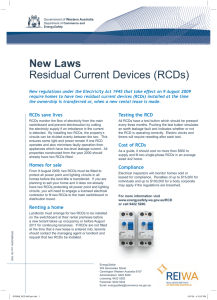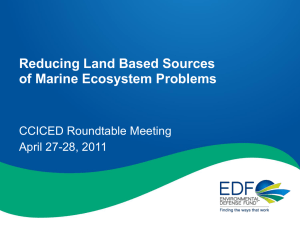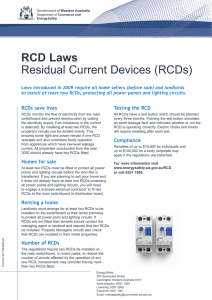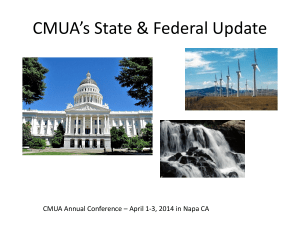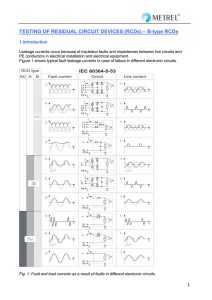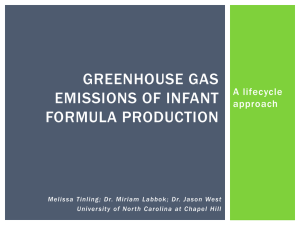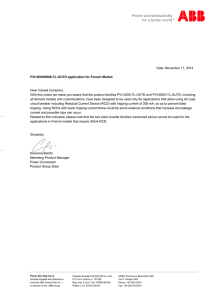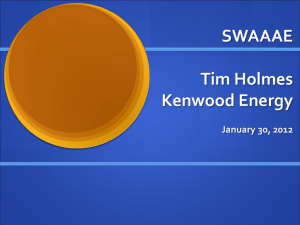Ami Gunasekara, CDFA - California Association of Resource
advertisement
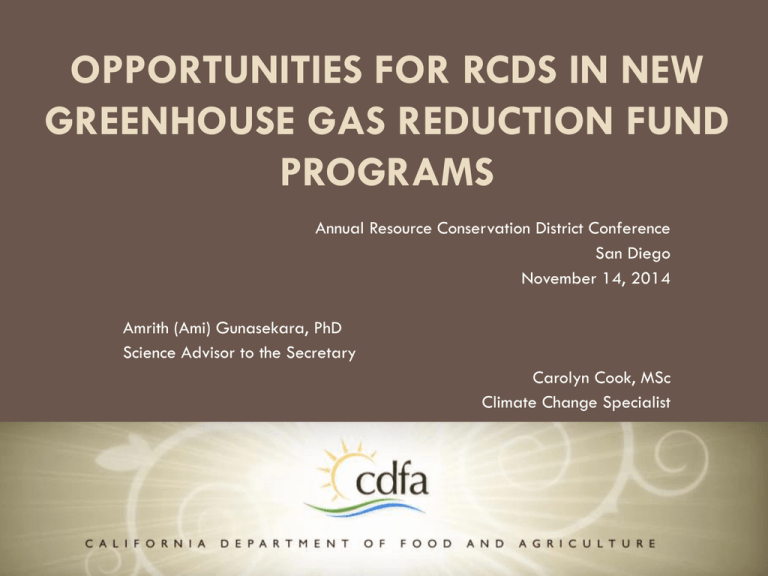
OPPORTUNITIES FOR RCDS IN NEW GREENHOUSE GAS REDUCTION FUND PROGRAMS Annual Resource Conservation District Conference San Diego November 14, 2014 Amrith (Ami) Gunasekara, PhD Science Advisor to the Secretary Carolyn Cook, MSc Climate Change Specialist THE GGRF 2 The Legislature and Governor appropriate proceeds from the sale of State-owned allowances for projects that support the goals of AB 32. Strategic investment of these proceeds furthers the goals of AB 32 by reducing GHG emissions, providing net GHG sequestration, and supporting the longterm, transformative efforts needed to improve public and environmental health and develop a clean energy economy. THE DROUGHT AND SB 103 3 Emergency drought legislation bill (SB 103) signed by Governor Brown on March 1, 2014 $10 million from the Greenhouse Gas Reduction Fund for the California Department of Food and Agriculture to invest in irrigation and water pumping systems that reduce water use, energy use and greenhouse gas emissions http://gov.ca.gov/news.php?id=18432 MORE ON SB 103 CDFA as the lead agency states; “$10,000,000 shall be available for encumbrance until June 30, 2015, for consultation and coordination with the Department of Water Resources (DWR) and the State Water Resources Control Board (SWRCB), to establish and implement a program, on or before July 1, 2014…." "…to provide financial incentives to agricultural operations to invest in water irrigation treatment and distribution systems that reduce water and energy use, augment supply and increase water and energy efficiency in agricultural applications." "Incentives shall be ranked and distributed based on financial need, immediacy of water supply increased and efficiency gained to address water shortages, and reduction in water pumping or treatment that uses energy causing greenhouse gas emissions.” CDFA AUTHORITY Fits well under the Environmental Farming Act of 1995. Division 1, Part 1, Chapter 3, Article 8.5, Sections 560-568 Section 566. (a) The department shall establish and oversee an environmental farming program. The program shall provide incentives to farmers whose practices promote the wellbeing of ecosystems, air quality, and wildlife and their habitat. Act posted online at; http://www.cdfa.ca.gov/EnvironmentalStewardship/pdfs/CannellaEnvironment alFarmingAct.pdf SWEEP 6 First round Must reduce water OR GHG; $50,000 max Funded 93 applications at $3.6 million Total applications received = 130 (71% funded) Second round Must reduce water AND GHG; $150,000 max Application deadline Nov. 10, 2014; 321 applications submitted SWEEP – IMPORTANT PARTS 7 Online application Quantifiable water savings and GHG reductions Budget and matching funds Documentation required for data provided Schematic and project design Six month implementation period Use of NRCS Conservation Practices Review component (Universities) Verification component 8 9 10 11 OTHER OPPERTUNITES 12 Online application (RCDs) Quantifiable water savings and GHG reductions (RCDs) Budget and matching funds (RCDs) Documentation required for data provided Schematic and project design (RCDs) Six month implementation period Use of NRCS Conservation Practices(RCDs) Review component (Universities) Verification component (RCDs) Assisting growers with project implementation OTHER OPPERTUNITES 13 CDFA is working with NRCS to develop GHG reduction estimates for its conservation practices. GGRF $ can be used to incentivize the implementation of conservation practices on working lands including rangelands Conservation practices focused on carbon sequestration and soil health (building recalcitrant organic matter pools and GHG reductions) Requires long term verification where RCDs might be able to play a role in Discussion topic in SGC and in DOC Thanks! http://ericjacobsononmanagement.blogspot.com Amrith (Ami) Gunasekara, PhD Science Advisor to the Secretary Amrith.gunasekara@cdfa.ca.gov
